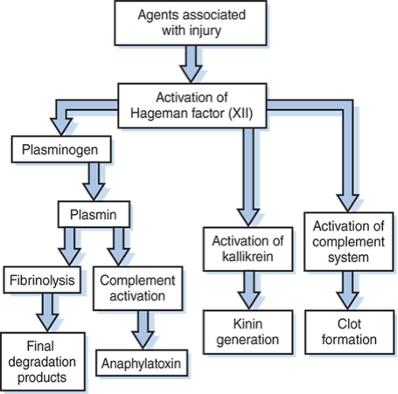Inflammation and Tissue Repair
1/44
There's no tags or description
Looks like no tags are added yet.
Name | Mastery | Learn | Test | Matching | Spaced |
|---|
No study sessions yet.
45 Terms
What are the phases of tissue healing?
Inflammation - day 1-6 (0-3)
proliferation - day 3-20 (3 days - 6 weeks)
maturation - day 9 on (>6 weeks)
What happens at the inflammation phase of tissue healing?
prepares wound for healing - immediate protective response to destroy, dilute, or isolate the cells or agents that may be at fault
What happens if no inflammation occurs, what happens?
healing cannot take place!
What are the interventions for inflammation?
assist/don’t inhibit healing process
protection of injury site
pain and swelling control
What will you see with inflammation?
heat - increased vascularity/blood flow
redness - increased vascularity/blood flow
swelling - blockage of lymphatic drainage
pain - physical pressure or chemical irritation of pain (sensitive structures)
loss of function - pain/swelling
What is the vascular response to inflammation?
histamine released by mast cells, platelets, and basophils at the injury site
What is extravasation?
movement of cells from inside to outside of the vessel
What is the pathway for extravasation?
margination - cells/neutrophils go to the margin of the vessels
pavementing - go on the side of the vessels
diapedesis - sneak through damaged area of the vessel and go outside the cell
emigration - going to move towards the source of the injury by picking up mediators that are going to attach to the cell
What is chemotaxis?
ability of a chemical to attract cells
What is edema?
accumulation of fluid in extravascular space/interstitial tissues
What increases cause edema?
increased capillary hydrostatic pressure
increased interstitial osmotic pressure
increased venule permeability
overwhelmed lymph system
What is clinical swelling?
ecchymosis
What is effusion?
escape of fluid into a body cavity
What is a hematoma?
accumulation of blood in a tissue or organ
What is hemarthrosis?
bloody fluid in a joint
What is the hemostatic response to inflammation?
retraction and sealing off of blood vessels

What is the cellular response to inflammation?
plasma = erythrocytes, leukocytes, and platelets
leukocytes
neutrophils
monocytes
What are leukocytes?
polymorphonucleocytes - neutrophils, basophils, eosinophils
mononuclear - monocytes
both clean up, recruit, and promote repair
What are neutrophils?
highest concentration in blood so prominent in early phase of inflammation
active for 24 hours
What are monocytes?
converted to macrophages - active for 24-48 hours
considered MOST important cell in the inflammatory phase and is essential for wound healing
produce wide range of chemicals that attract other agents important for the healing process
phagocytosis
produce collagenase
When are macrophages most effective?
when O2 is present in affected tissues
Adequate O2…
assists in healing and minimizing risk of infection
What is the immune response to inflammation?
macrophage → T cells → B cells → plasma cells → antibodies
What happens at the proliferation phase of tissue healing?
cover wound/provide strength
rebuilds damaged structures
What are the interventions for the proliferation phase?
still protection
early to control the direction of the scar
prevent scar from limiting motions
progressive vigor as the strength of the tissues are adequately recovered to prevent scar adhesions, and to promote functional length
What is epithelialization?
keep what we want IN, what we don’t OUT
IN - fluid, electorlytes
OUT - foreign materials, bacteria
superficial - occurs within a few hours
deep - after collagen production and neovascularization
What starts and stops the process of epithelialization?
contact inhibition
What does collagen production do?
undifferentiated mesenchymal cells → fibroblasts +O2, ascorbic acid, zinc, iron, manganese, copper = fibroplasia
fibroblasts → procollagen → tropocollagen → microfibril → fibril → fiber
production of hyaluronic acid and GAG’s help to increase intracellular matrix and facilitate cellular migration
initial layer is very weak!!! - type III collagen
very limited tensile strength - as little as 15% of normal tissue
infection, edema, and/or excessive stress on tissue can further inflammation and scarring
What happens on day 12 of collagen production?
type III collagen being replaced by type I
What happens on day 21 of collagen production?
wound strength 20% of normal
What happens in 6 weeks of collagen production?
wound strength 80% of normal
What is wound contraction?
at ~5 days, myofibroblasts are primarily responsible for “shrinking of the wound” by pulling edges inward
uncontrolled wound contracture = tissue contracture
What are contractures?
conditions of fixed shortening of soft tissues that have high resistance to passive stretch - may result from adhesions, muscle shortening, or tissue damage
What is neovascularization?
development of a new blood supply to injured tissues - angiogenesis
necessary to bring O2 and nutrients to healing tissue
thought to be initiated by macrophages
immediate vascularization surrounds the injured area giving a red/pink hue
What happens at the maturation phase of tissue healing?
restoration of the prior function of the injured tissue
change in size, form, and strength of scar tissue
modifies scar tissue into its mature form
In hypertrophic scars:
pressure DECREASES O2 = decreased synthesis
What is the induction theory?
scar mimics the tissue it is healing
What is the tension theory?
scar responds to tension applied upon it
What are the forces thought to affect collagen structure?
muscle tension, joint movement, soft tissue loading and unloading, fascial gliding, temperature changes, mobilization
What are the two most impactful variables for successful remodeling?
phase of the repair process which mechanical forced were inducted
nature of the applied forces
Applying tension during healing…
increases tensile strength in healing tissue
What do immobilization and stress deprivation do?
decreased tensile strength and collagen structure
What are the interventions for the maturation phase?
tension to control direction of scar, greater than previous phase
preparing for return to previous level of function
What are the local factors that can affect tissue healing?
injury type, size, location
tissue type
infection
vascular supply
external forces
MOVEMENT!
What are the systemic factors that can affect tissue healing?
patient co-morbidities/disease
patient nutrition
patient age
time since injury
medications